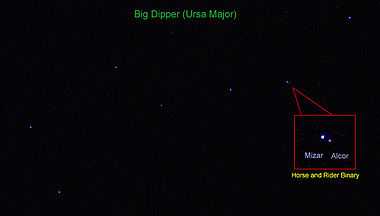Vashistha
Vashistha (Sanskrit: वशिष्ठ, वसिष्ठ, Thai: Vasit) is one of the Saptarishis (Seven Great Sages Rishi) in the seventh, i.e. the present Manvantara.[1] Vashista is a manasputra of God Brahma. He had in his possession the divine cow Kamadhenu, and Nandini her child, who could grant anything to their owners. Arundhuti is the name of the wife of Vashista. RigVeda 7:33 mentions Vashistha rishi as son of MitraVaruṇa and Urvasi.[2][3]

Vashistha, as one of 9 Prajapatis, is credited as the chief author of Mandala 7 of the Rigveda. Vashistha and his family are glorified in RV 7.33, extolling their role in the Battle of the Ten Kings, making him the only mortal besides Bhava to have a Rigvedic hymn dedicated to him. Another treatise attributed to him is "Vashistha Samhita" - a book on the Vedic system of electional astrology.
Arundhati and Vashistha pair of stars

Mizar is known as Vashistha and Alcor is known as Arundhati in traditional Indian astronomy.[4] The pair is considered to symbolize marriage (Vashishtha and Arundhati were a married couple) and, in some Hindu communities, priests conducting a wedding ceremony allude to or point out the constellation as a symbol of the closeness marriage brings to a couple.[5]
Vashistha
In the Vinaya Pitaka of the Mahavagga (I.245)[6] section the Buddha pays respect to Vashistha by declaring that the Veda in its true form was declared to the Vedic rishis "Atthako, Vâmako, Vâmadevo, Vessâmitto, Yamataggi, Angiraso, Bhâradvâjo, Vâsettho, Kassapo, and Bhagu"[7] and because that true Veda was altered by some priests he refused to pay homage to the altered version.[8]
Vashistha head
A copper item representing a human head styled in the manner described for the Rigvedic. Vashistha has been dated to around 3700 B.C. in three western universities using among other tests carbon 14 tests, spectrographic analysis, X-ray dispersal analysis and metallography.[9] This indicates that some Rigvedic customs were already known at a very early time. The head was not found in an archaeological context, as it was rescued from being melted down in Delhi. In one his discourses, Sathya Sai Baba declared that Lord Rama walked Earth more than 20,000 years ago; Vashishta was guru (teacher) of Rama, and lived a long age before Rama.
Gotra
In Nepali Gotra system Bhattarai,((Dawadi)), Bhandari, Suyal, Raut, Suyel, Thansinge Bharadi, Dharti Kharel comes under Vasishta Gotra.
See also
References
- ↑ Woodroffe, Sir John (1913). "Introduction and Preface". Mahānirvāna Tantra: Tantra of the Great Liberation. London: Luzac & Co. OCLC 6062735.
- ↑ "according to Rig Veda 7.33:11 he is the son of Maitravarun and Urvashi" Prof. Shrikant Prasoon, Pustak Mahal, 2009, ISBN 8122310729, 9788122310726.
- ↑ "Born of their love for Urvasi, Vasiṣṭha thou, priest, art son of Varuṇa and Mitra; And as a fallen drop, in heavenly fervour, all the Gods laid thee on a lotus-blossom."
- ↑ V.Chandran. Astronomy Quiz Book. Pustak Mahal, 1993. ISBN 978-81-223-0366-7. "... the seven rishis in the constellation Saptarishi (Ursa Major) ... In Vasishta (Zeta), its tiny companion star is named after Arundhati, the wife of Vasishta ... today known by their Arabic names Dubhe (Kratu), Merak (Pulaha), Phekda (Pulastya), Megrez (Atri), Benetnash (Marichi) and Mizar (Vasishta) ..."
- ↑ M.K.V. Narayan. Flipside of Hindu Symbolism: Sociological and Scientific Linkages in Hinduism. Fultus Corporation, 2007. ISBN 978-1-59682-117-0. "... At this time, the pundit shows the couple the Arundhati star in the sky to suggest closeness of the married couple. ... the star Vasishta of the Big Dipper constellation (Saptarishi Mandalam) and it is the star system called Mizar ..."
- ↑ P. 494 The Pali-English dictionary By Thomas William Rhys Davids, William Stede
- ↑ P. 245 The Vinaya piṭakaṃ: one of the principle Buddhist holy scriptures ..., Volume 1 edited by Hermann Oldenberg
- ↑ The Vinaya Pitaka's section Anguttara Nikaya: Panchaka Nipata, P. 44 The legends and theories of the compared with history and science By Robert Spence Hardy
- ↑ Hicks and Anderson. Analysis of an Indo-European Vedic Aryan Head - 4500-2500 B.C., in Journal of IE studies 18:425-446. Fall 1990.
Literature
- Atreya, B L (1981 (1st ed. 1935)). The Philosophy of the Yoga Vashista. A Comparative Critical and Synthetic Survey of the Philosophical Ideas of Vashista as presented in the Yoga-Vashista Maha-Ramayan. Based on a thesis approved for the degree of Doctor of Letters in the Banaras Hindu University. Moradabad: Darshana Printers. p. 467 pages.
- Atreya, B L (1993). The Vision and the Way of Vashista. Madras: Indian Heritage Trust. p. 583 pages. OCLC 30508760. Selected verses, sorted by subject, in both Sanskrit and English text.
- Vālmīki (1982, 2002). The Essence of Yogavaasishtha. Compiled by Sri Jnanananda Bharati, transl. by Samvid. Chennai: Samata Books. p. 344 pages. Sanskrit and English text.
- Vālmīki (1976). Yoga Vashista Sara: The Essence of Yoga Vashista. trans. Swami Surēśānanda. Tiruvannamalai: Sri Ramanasramam. p. 29 pages. OCLC 10560384. Very short condensation.
| |||||||||||||||||||||||||||||||
| |||||||||||||||||
| ||||||||||||||
